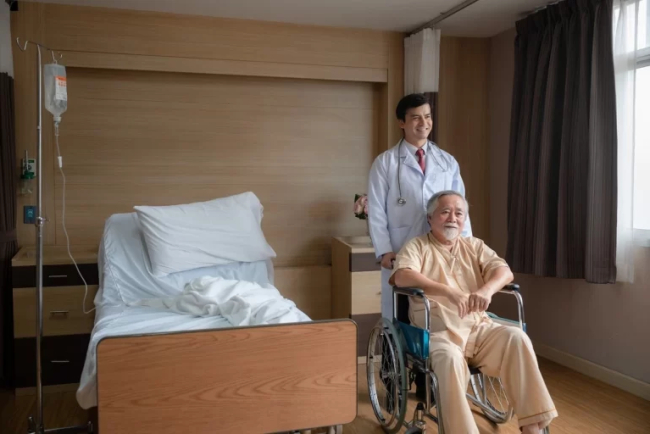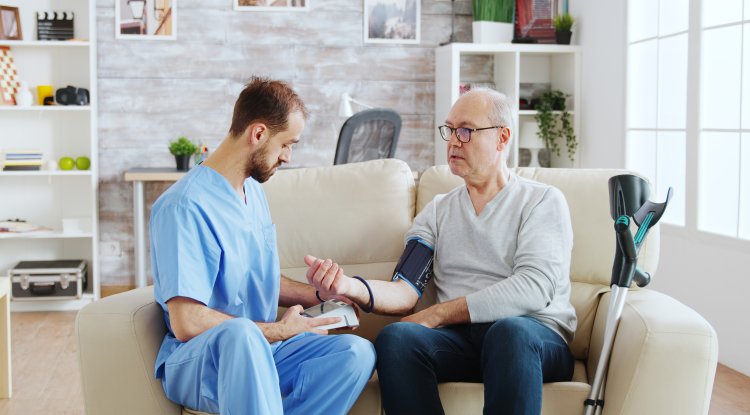Preparing Your Home for Professional Nursing Care: Checklist & Tips
Prepare your home for professional nursing care with our easy checklist and expert tips to ensure comfort, safety, and seamless recovery for your loved ones.

Why Home Preparation Matters for Professional Nursing Care
When a loved one is returning from the hospital or needs long-term support, the house suddenly feels like a mini care centre. Preparing your home for professional nursing care is not just about space for a bed and medicines; it’s about creating a safe, calm and hygienic environment where healing actually feels possible. With more families choosing home nursing care instead of extended hospital stays, a well-organised home can make a big difference to recovery, dignity and peace of mind.
A nurse can do their best work only when the surroundings support them. Clear pathways, good lighting, clean washrooms, and easy access to medical supplies save precious time and reduce avoidable risks, such as falls or infections. For the patient, small details such as fresh linens, proper ventilation, and privacy can turn everyday care into a more comfortable and less stressful experience.
In simple terms, preparing your home for professional nursing care involves creating a safe, hygienic and comfortable environment that supports medical recovery and nursing efficiency. This becomes even more important when caring for elderly parents or someone recovering from surgery, stroke or chronic illness at home.
You don't need a big or fancy house to get this right—just clarity, planning and the right checklist. In this guide, you'll find a practical home nursing care checklist and expert setup tips, covering room arrangements, safety, hygiene, essential equipment, and communication with your nurse. By the end, you'll know exactly what to do before care begins so that every visit feels smoother, more confident and truly focused on healing.
Understanding Professional Nursing Care at Home
Professional nursing care at home means bringing hospital-level clinical support into the comfort and familiarity of the patient's own house. Instead of shifting a weak or elderly person to the hospital for every small procedure, a trained nurse visits or stays at home and follows the doctor's plan. This can include post-surgery dressing and monitoring, elderly care for bedridden or confused patients, and long-term support for chronic illnesses such as stroke, heart disease, cancer or neurological conditions. In many cases, it also covers palliative care, where the goal is comfort, dignity and pain management.
In home nursing care , the nuse's role goes far beyond basic help. They administer medicines on time, check and record vital signs, dress wounds, manage catheters or IV lines, prevent bed sores, support safe mobility, and watch for early warning signs that require a doctor's attention. These home healthcare services are delivered with strict hygiene and documentation so that the treating doctor can track progress.
It is important to understand the difference between personal care and medical care at home. Personal care focuses on bathing, grooming, feeding and companionship. Medical care adds clinical judgement, infection control and procedures that only a qualified nurse should perform. Most families need some mix of both.
When planned well, home-based recovery offers numerous benefits: reduced exposure to hospital infections, lower stress levels, improved sleep, and increased emotional support from family. With the right patient care at home preparation, your house becomes a safe care environment where the nurse, doctor and family work together to support healing. For more detailed guidance after surgery, you can also refer to our related post, “Post-Surgery Care Services at Home in Bangalore – Aayan Global.”
Why Home Preparation Is Important Before Nursing Care Begins
Preparing your home before professional nursing care begins is not just a formality; it directly affects how smoothly recovery happens. A well-organised home setup for patient care means the room is clean, clutter-free, and easy to move around in, with safe flooring, good lighting, and a washroom that the patient can reach without difficulty. This kind of environment lowers the risk of falls, infections and fatigue for someone who is already weak or in pain.
When everything is ready in advance, stress levels drop dramatically for both the patient and the caregiver. The patient feels more secure and respected, while the nurse can focus on care instead of shifting furniture, hunting for extension cords or rearranging the room. Families also feel calmer because they know where medicines, reports and basic equipment are kept.
Proper planning also helps you avoid last-minute challenges that can disrupt treatment, such as power outlets too far from the bed, narrow pathways for wheelchairs, or no sturdy support near the toilet or bathing area. By preparing the home for patient recovery step by step—checking access, furniture placement and electrical points—you create a healing space that supports medical care instead of working against it. In simple terms, good preparation turns your home into a safe mini-care unit, where every movement, procedure, and conversation becomes easier, calmer, and more effective.
Step-by-Step home care services list
This step-by-step home nursing care checklist helps you turn your house into a practical, healing space before professional support begins. Instead of rushing on the first day, you can calmly walk through each area and confirm that the basic "things to do before the nurse arrives" are completed. Use the following sections as a working guide and tick items off as you prepare.
A. Patient Room Setup
Start with the room where the patient will spend most of their time. Choose a quiet, well-ventilated room with enough space to move around the bed. If possible, place an adjustable hospital bed; otherwise, use a firm, clean mattress set at a height that makes it easy for the nurse to work and the patient to sit or stand with support.
Position the bed so that at least one side is fully accessible to the nurse. Keep a sturdy bedside table for medicines, water, tissues, a call bell or phone, spectacles and remote controls. Arrange a chair or stool for the nurse and a separate one for a family member. Keep curtains or blinds that allow natural light in during the day and privacy at night. If the patient is bed-bound, consider placing the room near a washroom to minimise movement and effort.
B. Safety & Accessibility3
Next, walk through the room and surrounding areas as if you are the patient. Clear narrow walkways, remove loose wires and secure rugs or mats that could cause slips. Ensure the patient can reach the washroom, door, and switches without obstacles, such as extra furniture, shoes, or buckets, blocking the way.
Install grab bars or strong wall handles near the bed, corridor turns and washroom if the patient has balance issues. Use non-slip mats in the bathroom and near any water source to prevent slips and falls. Ensure the lighting is bright yet gentle, especially in areas such as near steps, corners, and the toilet. Keep a small night lamp on so that the patient and nurse can move safely at night without turning on harsh lights.
C. Hygiene & Sanitation
Hygiene is a core part of this Home nursing care in Bangalore . Deep-clean the patient’s room and washroom before care starts—dust surfaces, wipe windows, disinfect door handles and switchboards. Change the bed linen, pillow covers and blankets, and keep at least two or three extra sets ready for quick replacement.
Assign separate towels, washcloths and a dedicated waste bin for medical and general waste. Line the bin with disposable bags for easy, hygienic disposal. Keep hand sanitisers, liquid soap, tissues and disposable gloves at an accessible spot near the bed or washroom. If the patient has wounds, catheters or tubes, ask the nurse about any extra hygiene precautions and follow them consistently. Good sanitation protects both patient and caregiver from infections.
D. Medical Supplies & Equipment
Before the first visit, confirm that the necessary medical equipment is available and functioning properly. Common essentials include a thermometer, BP monitor, pulse oximeter, glucometer if needed, and a small torch for checking pupils or throat. Stock disposable gloves, masks, sterile gauze, cotton, tape and a simple dressing kit if the doctor has advised wound care at home.
If specialised equipment is prescribed—such as an oxygen concentrator, nebuliser, suction machine, air mattress, or IV stand—set it up in advance and ensure there are enough power points and extension cords. Keep all medicines in one organised tray or box, clearly labelled with name, dosage and timing. Share this arrangement with the nurse so they can quickly cross-check prescriptions and maintain accurate records.
E. Nutrition & Comfort
Recovery is not only about medicines; food, water and emotional comfort matter just as much. Discuss a basic diet plan with your doctor or nurse, and stock your kitchen with appropriate items, such as soups, fruits, and soft foods or diabetic-friendly options, as needed. Prepare a simple hydration or feeding chart so family members and the nurse can record intake throughout the day.
Within the room, keep a covered water bottle, a spoon, a glass, and a napkin on the bedside table. Arrange for extra pillows, backrest support or cushions so the patient can sit up comfortably for eating, reading or watching TV. Small comforts, such as a favourite blanket, books, soft music, or family photos, can lift one's mood and reduce anxiety. Make sure there is a fan or AC with easy controls and that the room temperature stays comfortable.
F. Coordination With Nurse & Family
Finally, good coordination ties the entire home nursing care checklist together. Before regular visits begin, keep all hospital discharge summaries, prescriptions, lab reports, and scan copies in one labelled file. Share a brief written note on the patient's routine, including usual sleep time, food preferences, allergies, habits, and any behavioural issues such as confusion or restlessness.
At the start, discuss clear 'dos' and 'don'ts' with the nurse, including lifting restrictions, movement limits, dietary boundaries, and pain-relief guidelines from the doctor. Create a simple communication logbook or sheet where the nurse can note vitals, medicines given, observations and any concerns for the doctor or family. Encourage key family members to read this log daily. This kind of planned coordination is one of the most important "things to do before the nurse arrives" and continues to keep everyone aligned throughout the care journey.
Tips to Make the Home More Comfortable for the Nurse and Patient
Making the home comfortable for both the nurse and the patient is a simple but powerful part of good care. When you think intentionally about how to prepare your home for a nurse visit, you make it easier for the nurse to focus on treatment and for your loved one to relax. Start by clearly defining the nurse's workspace around the patient's bed. Keep this area clear of unnecessary chairs, bags, footwear, and household items. Avoid constantly rearranging things once the nurse has set them up; it shows respect for their clinical workflow and helps them work safely and confidently.
Privacy is equally important. Close doors or use curtains when procedures, dressing changes or sponge baths are done. Ask family members to knock before entering and avoid crowding inside the room. A calm, quiet atmosphere reduces stress for the patient, allowing the nurse to speak, observe, and think clearly. Lower the TV volume, manage phone calls outside the room, and discourage curious visitors from using the room as a meeting place. If relatives want updates, fix a time outside the room to brief them so that the patient's rest is not disturbed.
Keep a small board or sheet near the bedside with emergency contact numbers, including the primary doctor, a backup doctor if applicable, the nursing agency, the nearest hospital, and key family members. This saves valuable time if something urgent comes up. As part of a practical home care setup guide for patients, fix visiting hours that match your family's routine—meal times, office schedules and school timings—so someone responsible is available to understand updates, clarify doubts and support the nurse when lifting or turning the patient. You can also keep a simple notepad where family and nurse record questions for the doctor. When nurses feel respected, informed and supported, they naturally go the extra mile, and the home environment starts to feel like a safe care partnership rather than a daily crisis.
Essential Equipment Checklist for Home Nursing Care
When planning for professional care at home, having the right home healthcare equipment ready saves time, prevents emergencies, and ensures consistent treatment. Start with medical monitoring tools. A good-quality digital BP monitor, thermometer and pulse oximeter should always be available near the patient's bed. If the patient is diabetic, add a glucometer with extra strips and lancets. For wound care, keep a basic dressing kit with sterile gauze, bandages, tape, saline solution, scissors, and antiseptic solution as advised by your doctor or nurse. These home care essentials are easily available at local medical stores, branded pharmacies and trusted online medical suppliers.
Next, arrange comfort and positioning aids as needed. A firm backrest pillow helps the patient sit up for meals or breathing exercises. Side railings on the bed reduce the risk of falls for elderly or restless patients. An over-bed table is extremely useful for food trays, charts, laptops or medical files, and can be adjusted in height so the nurse can work without strain. Many of these items can be rented from home healthcare companies if you do not want to purchase them outright.
Finally, focus on hygiene-related equipment. Keep alcohol-based sanitiser, disposable gloves, surgical masks and tissues stocked in one visible basket. Use a covered medical waste bin or yellow bag for used cotton, dressings and disposables, separate from normal household waste. If there is a risk of bedsores, ask about air mattresses or special cushions. Review this equipment list with your nurse or service provider so you buy the right brands and sizes. A small investment in the correct home healthcare equipment can make daily care safer, cleaner and far more efficient for everyone involved.
Safety Guidelines for Family Members
Home nursing works best when everyone in the house follows the same safety rules. As a simple home care safety guide, start by making masks and hand hygiene non-negotiable for the patient. Family members should wash their hands with soap or use sanitiser before touching the patient, medicines, food or medical devices. If anyone has a cold, fever or infection, they should avoid close contact and inform the nurse immediately.
Limit unnecessary visitors, even if they are emotionally supportive. Extra people increase the risk of infection and make it harder for the nurse to move freely. Fix short, quiet visiting times instead of allowing crowds in the room. One or two designated caregivers should talk directly to the nurse and doctor to avoid confusion in instructions.
Important safety tips for home nursing also include watching the patient without hovering. Learn basic warning signs—sudden breathlessness, chest pain, confusion, high fever, uncontrolled bleeding or unusual drowsiness—and know whom to call first in an emergency. Keep emergency numbers and medicine lists written and visible.
Finally, keep children and pets away from the patient's room unless the nurse says it is safe. Curious kids may accidentally touch equipment or pull tubes, and pets can bring germs or cause trips and falls. When families take safety seriously, home nursing becomes more effective, respectful and reassuring for everyone.
Common Mistakes to Avoid When Preparing for Nursing Care
Even caring families can unintentionally create problems when preparing a home for patient recovery. One of the biggest mistakes in home nursing setup is overcrowding the patient’s room. Too many chairs, side tables, bags or guests leave little space for the nurse to move equipment or reposition the patient safely. A healing room should feel open, calm and practical, not like a storage area or visitor lounge.
Another common issue is ignoring basic electrical checks. Loose plugs, overloaded extension boards and sockets far from the bed can interrupt oxygen concentrators, nebulisers or monitors at the worst possible time. Before care begins, test every power point, mark the main switches clearly and keep wires off walking paths. Where possible, dedicate one extension board only for medical devices.
Families also sometimes treat the room layout as “fixed” and overlook the nurse’s feedback. In reality, nurses see daily what works and what increases risk. If they suggest shifting the bed, changing mattress height or relocating the over-bed table, take it seriously and adjust quickly.
Finally, many homes forget backup power for critical equipment. In areas with frequent power outages, a basic inverter or UPS for key devices can be lifesaving. Reviewing these small but crucial points in advance prevents emergencies, protects the patient and allows the nurse to deliver care smoothly and confidently.
How Home Nursing Helps in Faster Recovery
One of the biggest home care benefits is the emotional comfort of familiar surroundings. When patients sleep in their own bed, hear normal household sounds and see family faces instead of hospital machines, their anxiety drops and cooperation with treatment improves. This emotional security supports the body's natural healing response and makes daily routines, such as eating, exercising, and taking medication, feel less stressful.
Another major advantage of recovery at home is lower exposure to hospital-acquired infections. With proper hygiene, ventilation and a disciplined nursing routine, the risk of catching new infections from other patients or visitors is significantly reduced. This is especially important for the elderly, post-surgery cases, and those with low immunity. A stable, clean home environment allows the nurse to focus on building strength rather than fighting fresh complications.
Home nursing also means highly personalised attention. The nurse is not juggling multiple beds; they can observe small changes in behaviour, sleep, appetite or pain levels and update the doctor quickly. Over time, this one-to-one care enhances trust, communication, and mental well-being for both the patient and their family.
When families understand these home care benefits clearly, they feel more confident choosing structured recovery at home with professional support. For guidance on picking the right provider, you can also refer to our detailed guide, “Top 10 Home Nursing Services in Bangalore – Aayan Global.”
Conclusion – Create a Safe, Healing Space at Home
Preparing your home for professional nursing care is really about giving structure to love and concern. A clean, organised and accessible space shows the patient that their comfort and dignity matter, and it allows the nurse to focus on care instead of constantly adjusting the surroundings. When safety, hygiene, equipment and communication are planned in advance, every visit feels calmer, more predictable and more effective.
This guide has walked you through room setup, safety measures, hygiene routines, essential equipment and family coordination so you can turn an ordinary house into a healing-friendly home. You don’t need expensive interiors to do this; you just need clarity, discipline and a practical checklist.
Start today by reviewing your home with this checklist and ensure a stress-free nursing experience for both your loved one and the care team. With the right preparation, preparing your home for professional nursing care becomes more than a task – it becomes a partnership in healing, where family, nurse, and patient work together in a safe and supportive space.
Get expert nursing care at home — book a professional caregiver today and ensure your loved one’s comfort, safety, and faster recovery!
FAQs – Home Nursing Preparation
Q1. How do I prepare my home for a nurse visit?
Start by keeping the patient's room clean, well-lit and clutter-free so movement is easy. Arrange the bed so the nurse can access at least one full side comfortably. Keep basic medical files, prescriptions and the home nursing care checklist ready before the nurse arrives.
Q2. What items are needed for home nursing care?
Key essentials include a bedside table, clean linen, sanitiser, thermometer, pulse oximeter, gloves and a small medical kit. If advised by the doctor, add equipment like a BP monitor, glucometer or oxygen support. Store everything together near the bed so your home setup for patient care stays organised.
Q3. How do I ensure patient safety at home?
Clear pathways, remove loose wires and secure rugs to prevent trips or falls. Install grab bars near the bed and in the bathroom, and use non-slip mats where the floors are likely to get wet. Good lighting and a readily accessible call bell or phone further enhance safety.
Q4. Can I prepare my home for post-surgery care?
Yes, preparing your home for professional nursing care after surgery is strongly recommended. Set up the room, washroom access and equipment before discharge so there is no rush on the first day. Follow the surgeon's instructions and share them in writing with the nurse.
Q5. What should family members know before nursing starts?
They should understand the patient's diagnosis, medicines, allergies and daily routine. Decide on one or two primary caregivers to coordinate with the nurse and doctor. Agree on hygiene rules, visiting times and emergency contacts to keep care smooth and confusion-free.
What's Your Reaction?















